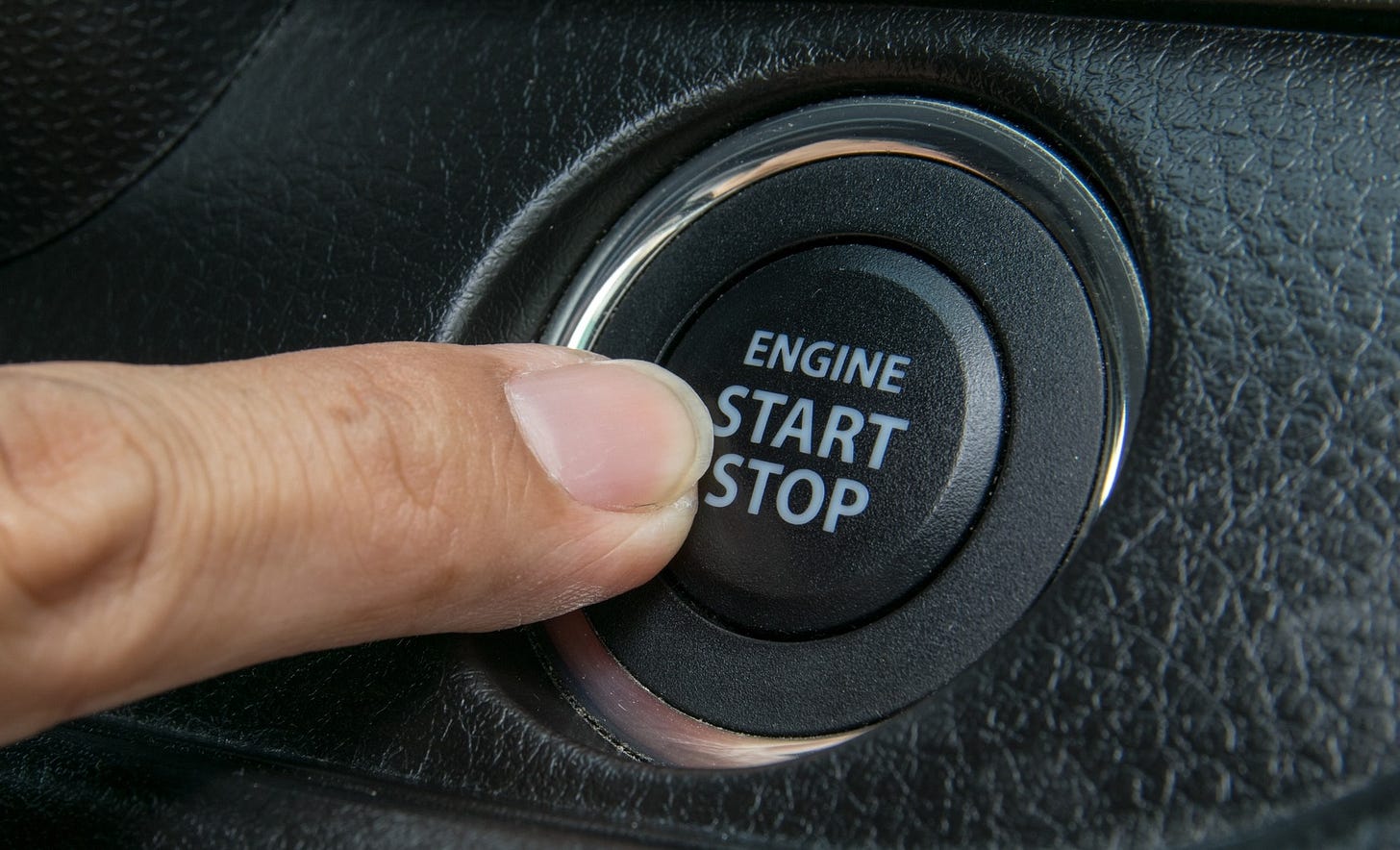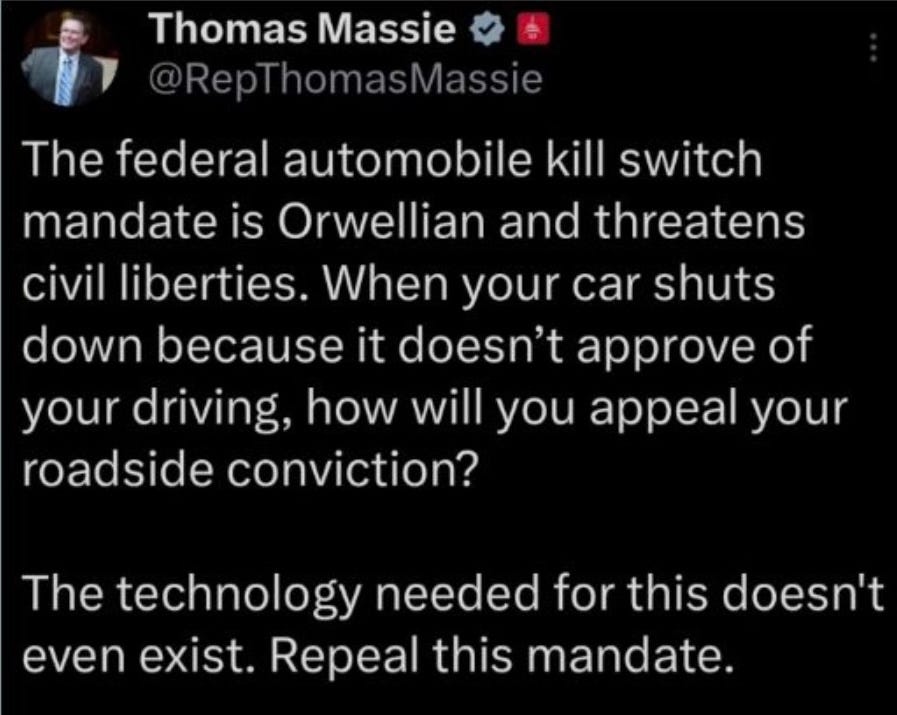Nancy Pelosi famously quipped about ObamaCare, back in 2010, "we have to pass the bill so that you can find out what is in it." Taken somewhat out of context (Snopes did its usual apologia, not entirely inaccurately, but not very critically either), the quip embodies the "public manager" attitude of too many of our public servants.
It outraged many and should have outraged many more, but as we know, ObamaCare, or more formally the misnamed (aren't they all?) Affordable Care Act is the law of the land, to the chagrin of many (myself included) who know it was a big step in the wrong direction.
The sentiment of Pelosi's quip remains broadly accurate despite the partial miscontextualization, as we keep hearing and reading about little nuggets buried in bills and regulations that none of us knew about when they were enacted.
Behold, one such.
Buried in Biden's $1.2T Infrastructure Investment and Jobs Act, first dubbed the INVEST In America Act and later nicknamed the Bipartisan Infrastructure Bill because 1% of House Republicans voted for it, is a section called Advanced Impaired Driving Technology that...
Are you sitting down?
...mandates that, once the technology is developed, all new vehicles sold in the US be equipped with technology that:
can passively monitor the performance of a driver of a motor vehicle to accurately identify whether that driver may be impaired; and prevent or limit motor vehicle operation if an impairment is detected;
can passively and accurately detect whether the blood alcohol concentration of a driver of a motor vehicle is equal to or greater than the blood alcohol concentration described in section 163(a) of title 23, United States Code; and
prevent or limit motor vehicle operation if a blood alcohol concentration above the legal limit is detected;
In other words, your new car will be required to figure out, whether via erratic driving or some sort of "sniffer" of the cabin or perhaps even a blow tube, if you're not fit to drive, and to shut down if it comes to that determination.
AKA, your new car will have a kill switch over which you will have no control.
As the fine folks at FEE report, various laughably named "fact checkers" declared this false or mostly false, so I've copy-pasted the full text of the section below, just so you don't think I'm making this up.
Oh, gee, what could possibly go wrong here?
Apart from the questions about whether the technology to do this to a very low degree of error is even possible, there are major civil liberties issues at hand. Yes, it has been determined that driving on public roads is a privilege rather than a right, but law enforcement still requires probable cause to subject you to a sobriety test. Can an algorithm take the place of a police officer? How does our right "to be confronted with the witnesses against [us]" as guaranteed by the 6th Amendment work against software and sensors?
Beyond that, what [redacted] right does the government have to electronically monitor my driving? As the FEE article notes, there's nothing that would preclude the NHTSA from gathering the data the new cars collect.
I'm sure there are people out there who are fine with such technologies. They are probably the same people who think that biometric locks on firearms are a good and workable idea, and who are fine with surveillance cameras on every street corner. We can debate all that, but a huge issue here is that this provision wasn't even debated. It wasn't made public, it wasn't discussed or questioned or advocated for or against. It was buried among the 436,000+ other words in the bill.
This highlights the peril of giant pieces of legislation that none of our elected officials have the time or wherewithal to fully read before being required to vote on them. It's only after the fact, after the bills are law and protests become moot, that such poison pills are discovered.
I could write pages of potential pitfalls of such technology. So could you.
We already have issues arising from the concept and question of ownership arising from the increasing use of software in cars. Now, our very ability to control the vehicles we supposedly own is being challenged. Unless we push back, and push back hard, that erosion will continue.
H.R.3684 - Infrastructure Investment and Jobs Act
SEC. 24220. Advanced Impaired Driving Technology.
(a) Findings.--Congress finds that--
(1) alcohol-impaired driving fatalities represent
approximately \1/3\ of all highway fatalities in the United
States each year;
(2) in 2019, there were 10,142 alcohol-impaired driving
fatalities in the United States involving drivers with a blood
alcohol concentration level of .08 or higher, and 68 percent of
the crashes that resulted in those fatalities involved a driver
with a blood alcohol concentration level of .15 or higher;
(3) the estimated economic cost for alcohol-impaired driving
in 2010 was $44,000,000,000;
(4) according to the Insurance Institute for Highway Safety,
advanced drunk and impaired driving prevention technology can
prevent more than 9,400 alcohol-impaired driving fatalities
annually; and
(5) to ensure the prevention of alcohol-impaired driving
fatalities, advanced drunk and impaired driving prevention
technology must be standard equipment in all new passenger motor
vehicles.
(b) Definitions.--In this section:
(1) Advanced drunk and impaired driving prevention
technology.--The term ``advanced drunk and impaired driving
prevention technology'' means a system that--
(A) can--
(i) passively monitor the performance of a
driver of a motor vehicle to accurately identify
whether that driver may be impaired; and
(ii) prevent or limit motor vehicle operation
if an impairment is detected;
(B) can--
(i) passively and accurately detect whether
the blood alcohol concentration of a driver of a
motor vehicle is equal to or greater than the
blood alcohol concentration described in section
163(a) of title 23, United States Code; and
(ii) prevent or limit motor vehicle operation
if a blood alcohol concentration above the legal
limit is detected; or
(C) is a combination of systems described in
subparagraphs (A) and (B).
(2) New.--The term ``new'', with respect to a passenger
motor vehicle, means that the passenger motor vehicle--
(A) is a new vehicle (as defined in section 37.3 of
title 49, Code of Federal Regulations (or a successor
regulation)); and
(B) has not been purchased for purposes other than
resale.
(3) Passenger motor vehicle.--The term ``passenger motor
vehicle'' has the meaning given the term in section 32101 of
title 49, United States Code.
(4) Secretary.--The term ``Secretary'' means the Secretary
of Transportation, acting through the Administrator of the
National Highway Traffic Safety Administration.
(c) Advanced Drunk and Impaired Driving Prevention Technology Safety
Standard.-- <<NOTE: Deadline.>> Subject to subsection (e) and not later
than 3 years after the date of enactment of this Act, the Secretary
shall issue a final rule prescribing a Federal motor vehicle safety
standard under section 30111 of title 49, United States Code, that
requires passenger motor vehicles manufactured after the effective date
of that standard to be equipped with advanced drunk and impaired driving
prevention technology.
(d) <<NOTE: Compliance. Time period.>> Requirement.--To allow
sufficient time for manufacturer compliance, the compliance date of the
rule issued under subsection (c) shall be not earlier than 2 years and
not more than 3 years after the date on which that rule is issued.
(e) <<NOTE: Determinations.>> Timing.--If the Secretary determines
that the Federal motor vehicle safety standard required under subsection
(c) cannot meet the requirements and considerations described in
subsections (a) and (b) of section 30111 of title 49, United States
Code, by the applicable date, the Secretary--
(1) <<NOTE: Extension. Deadline.>> may extend the time
period to such date as the Secretary determines to be necessary,
but not later than the date that is 3 years after the date
described in subsection (c);
(2) <<NOTE: Reports.>> shall, not later than the date
described in subsection (c) and not less frequently than
annually thereafter until the date on which the rule under that
subsection is issued, submit to the Committee on Commerce,
Science, and Transportation of the Senate and the Committee on
Energy and Commerce of the House of Representatives a report
describing, as of the date of submission of the report--
(A) the reasons for not prescribing a Federal motor
vehicle safety standard under section 30111 of title 49,
United States Code, that requires advanced drunk and
impaired driving prevention technology in all new
passenger motor vehicles;
(B) the deployment of advanced drunk and impaired
driving prevention technology in vehicles;
(C) any information relating to the ability of
vehicle manufacturers to include advanced drunk and
impaired driving prevention technology in new passenger
motor vehicles; and
(D) <<NOTE: Timeline.>> an anticipated timeline for
prescribing the Federal motor vehicle safety standard
described in subsection (c); and
(3) <<NOTE: Deadline. Reports.>> if the Federal motor
vehicle safety standard required by subsection (c) has not been
finalized by the date that is 10 years after the date of
enactment of this Act, shall submit to the Committee on
Commerce, Science, and Transportation of the Senate and the
Committee on Energy and Commerce of the House of Representative
a report describing--
(A) the reasons why the Federal motor vehicle safety
standard has not been finalized;
(B) the barriers to finalizing the Federal motor
vehicle safety standard; and
(C) <<NOTE: Recommendations.>> recommendations to
Congress to facilitate the Federal motor vehicle safety
standard.




There is so much unconstitutional orwellianism so deeply embedded in government at all levels, I’m not sure how we return to being the land of liberty our founding fathers sought to bequeath to us.
The government has taken it upon themselves to save us from ourselves.